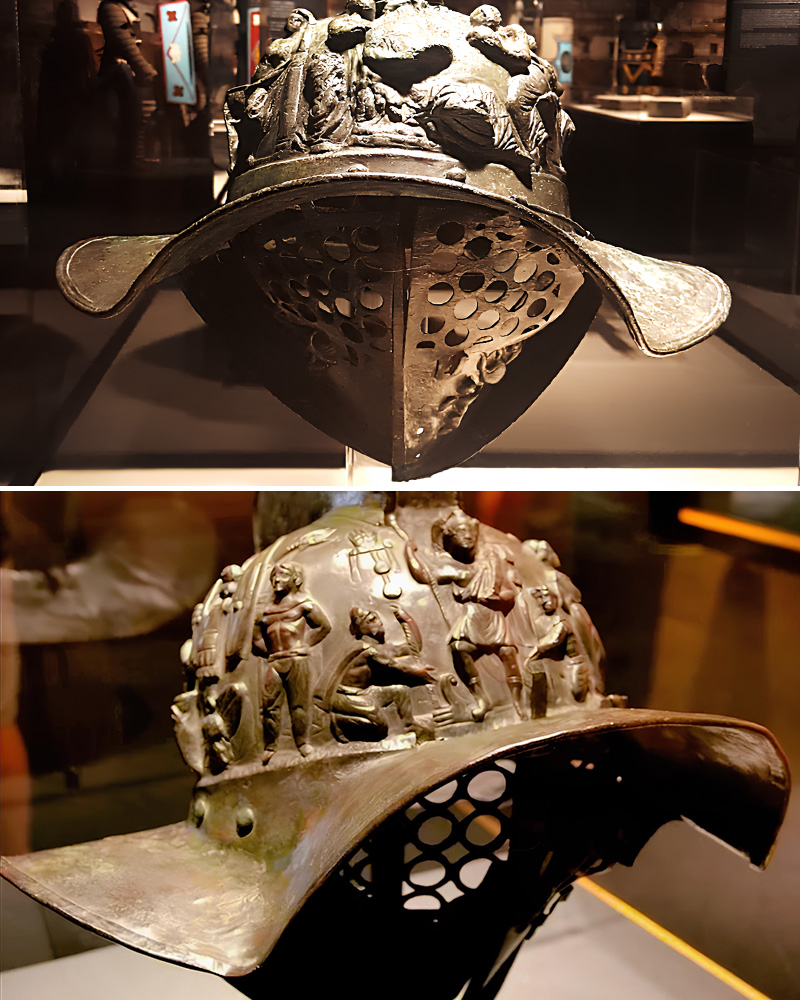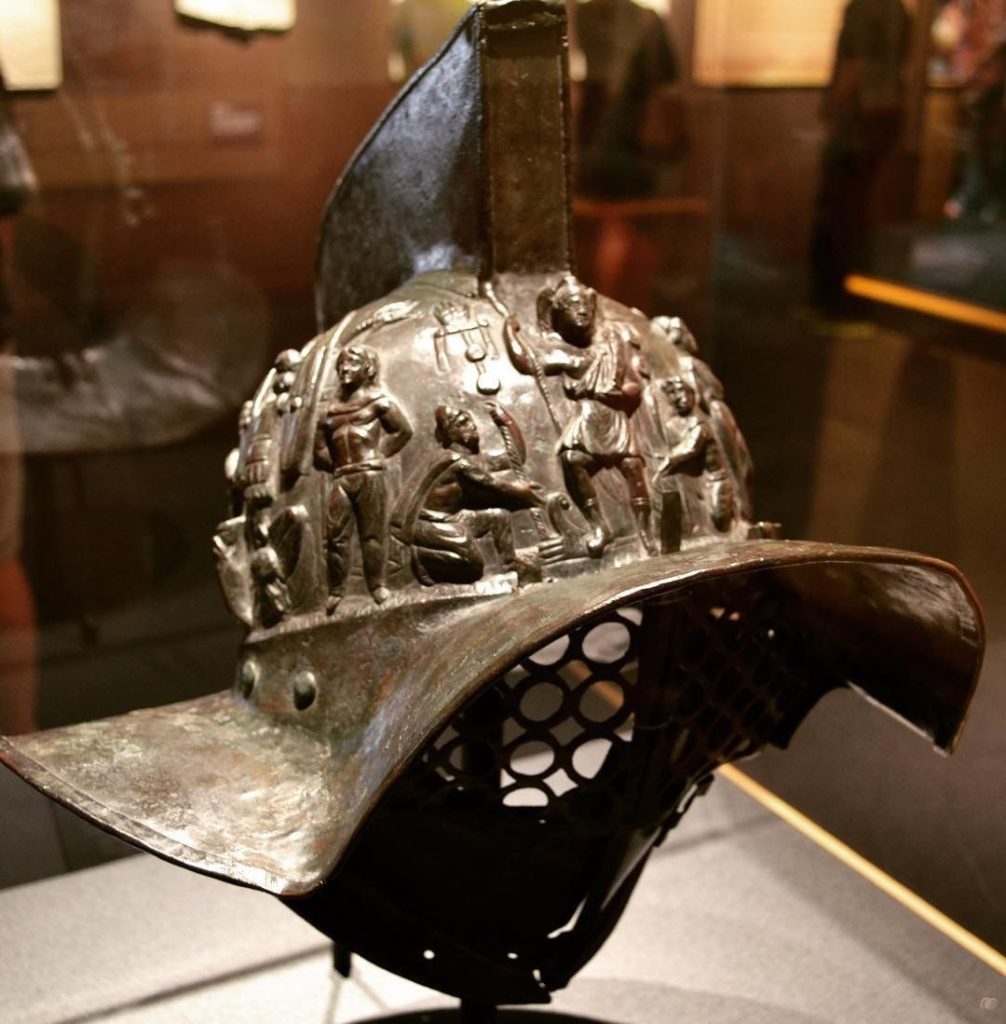Archaeology often brings to light the hidden treasures of history, and in a stunning recent discovery, archaeologists have unearthed a 2,000-year-old gladiator helmet from the ruins of the ancient city of Pompeii. This exceptional find not only enriches our understanding of the Roman Empire but also offers a rare and vivid glimpse into the lives of the gladiators who once captivated audiences with their bravery and skill in brutal combat.
The helmet, remarkably well-preserved despite the passage of two millennia, emerged from the depths of Pompeii, a city famously entombed by the catastrophic eruption of Mount Vesuvius in 79 AD. Crafted from bronze, the helmet displays an extraordinary level of detail, adorned with intricate engravings that reflect the artistry and technical expertise of Roman metalworkers. Such craftsmanship speaks volumes about the value placed on gladiatorial gear and its role as both protective equipment and a symbol of status in the bloody spectacles of ancient Rome.

The discovery of this helmet is more than just the unearthing of a relic; it is a gateway into understanding the lives of gladiators, the men who donned such helmets to fight for survival and glory. Gladiatorial games were a cornerstone of Roman entertainment, drawing immense crowds to amphitheaters across the empire. These contests, often held to commemorate significant events or honor the dead, were not merely brutal displays of violence but also a reflection of Roman values, social structures, and cultural identity.
The helmet’s design offers fascinating clues about its origins and usage. The ornate engravings and sturdy construction suggest it may have belonged to a highly skilled and possibly celebrated gladiator. Such fighters were often seen as both celebrities and slaves, trained rigorously in gladiator schools and subjected to a life of hardship. Despite their low social status, some gladiators achieved fame and fortune, and their equipment would have mirrored their prominence in the arena.
For the city of Pompeii, the discovery is a poignant reminder of a community frozen in time. Pompeii was a thriving hub of commerce, culture, and entertainment before it was buried under volcanic ash and pumice. The preservation of artifacts like this helmet provides a unique window into the daily lives of its inhabitants, from the elite who sponsored gladiatorial games to the common citizens who eagerly filled the stands to watch these dramatic battles unfold.
This helmet also underscores the multifaceted role of gladiatorial combat in Roman society. While these games were undeniably violent, they also served as a form of social cohesion, reinforcing the power of Rome’s rulers and their ability to provide both punishment and spectacle. The games were arenas where life and death played out as public theater, emphasizing themes of courage, endurance, and the triumph of skill over adversity.
The preservation and study of this artifact are crucial to unlocking further secrets about the Roman Empire. Researchers are now preparing the helmet for detailed analysis, employing advanced technologies to examine its composition, manufacturing techniques, and potential inscriptions or symbols that could reveal more about its owner. These efforts aim to piece together the story of the gladiator who once wore it, bringing to life a narrative that has been buried for centuries.
Plans are already underway to display this extraordinary artifact in a museum, where it will join a collection of other treasures from Pompeii. The public will have the opportunity to see this helmet up close, marveling at its craftsmanship and considering the historical context of its use. Such exhibits play a vital role in connecting modern audiences to the ancient world, fostering an appreciation for the complexities and achievements of past civilizations.
As the helmet takes its place among the storied artifacts of history, it serves as a reminder of the enduring legacy of Rome and the lessons we can glean from its rise and fall. The gladiators, whose lives were marked by struggle and spectacle, embody themes that resonate even today—the human desire for recognition, the pursuit of excellence, and the tension between freedom and constraint.
In a broader sense, this discovery highlights the power of archaeology to bridge the gap between the ancient and modern worlds. Each artifact, whether a helmet, a mosaic, or a piece of pottery, carries with it a story waiting to be told. These relics are not just remnants of a bygone era but active participants in the narrative of human history, helping us understand who we are and where we come from.

The helmet’s discovery also underscores the importance of preserving and studying archaeological sites like Pompeii. With its unique combination of tragedy and preservation, Pompeii offers an unparalleled glimpse into ancient Roman life. The ongoing excavations and research continue to reveal new facets of this once-vibrant city, reminding us of the fragility of human endeavors and the resilience of cultural memory.
As researchers delve deeper into the helmet’s origins, there is hope that it may shed light on broader questions about gladiatorial culture and the role of entertainment in ancient Rome. What motivated individuals to become gladiators? How did their training and equipment evolve over time? What can their experiences teach us about the values and priorities of Roman society? These are just a few of the questions that this artifact might help answer.
Ultimately, the 2,000-year-old gladiator helmet stands as a testament to the enduring fascination with the Roman Empire and its cultural achievements. It is a symbol of a world that, while long gone, continues to captivate and inspire. As it transitions from the ruins of Pompeii to the halls of a museum, the helmet’s story will be preserved for future generations, a tangible link to a time when the roar of the crowd and the clash of steel defined the heights of human drama.





